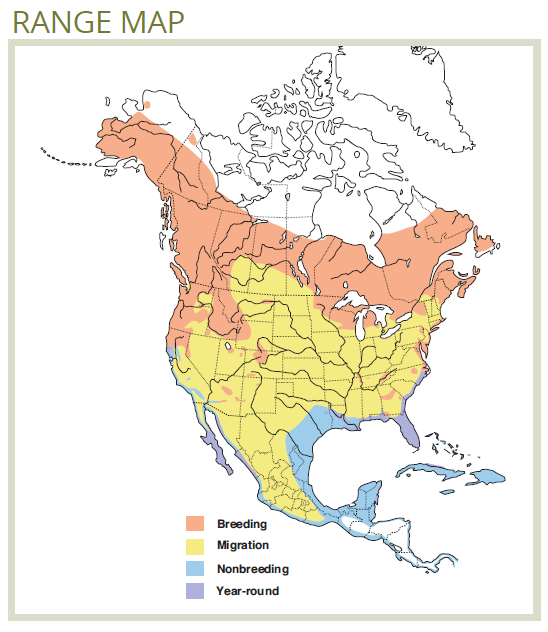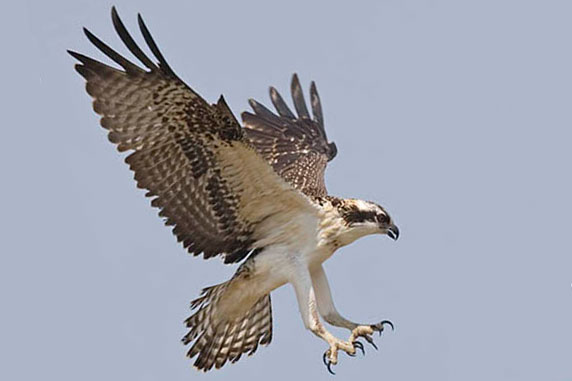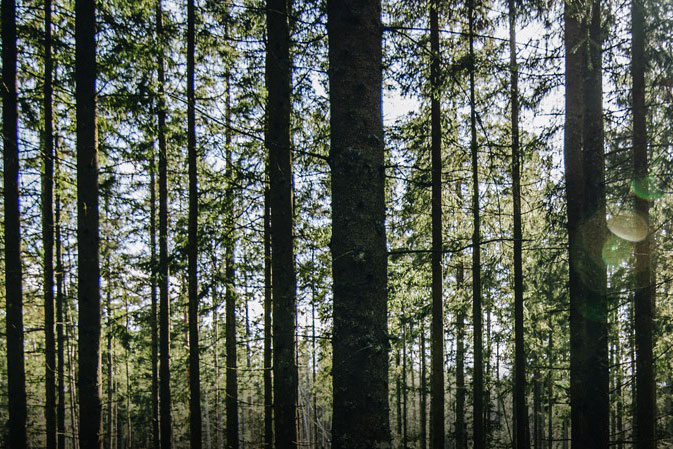The osprey is a striking raptor that nests near fish-bearing waters. Note that in BC, active and inactive Osprey nests are protected and government authorization is required to destroy them.1
Osprey
(Pandion haliaetus)
Habitat Ecology
- The Osprey is mainly found nesting within 1–2 km of fish-bearing waters, although it may nest up to 20 km away from these waters.2
- Platform nests are built on trees that are taller than the surrounding canopy and which often have flat tops (e.g., dead tops, broken tops, etc.). Nests may also be built on very tall snags.3
- Osprey nests have a high likelihood of reuse, either by Osprey or by other species.2,4

Response to Forest Management
- Harvesting that removes existing or potential nest trees (e.g., flat-topped trees taller than the canopy) negatively affects Osprey. This is particularly true of removal of existing nests, as they are very likely to be reused if left.3
- Osprey have been observed nesting on isolated residual trees and snags within clearcuts, however these isolated trees may be at higher risk of blowdown than patches.3
- Osprey responses to human disturbance are highly variable and appear to depend on whether individuals are habituated to human activity. Some pairs will breed successfully in heavily-developed areas, while pairs nesting in remote areas may be more likely to be disrupted by low amounts of disturbance.5
Stand-level Recommendations
- Platform nests should be protected even when not occupied due to their strong chance of future reuse.4
- Patch retention is recommended over single-tree retention to provide nest trees for Osprey.4
- Unharvested buffers around nests are recommended and studies generally suggest maintaining 1.8 ha (75 m radius) unharvested patches around platform nests that were occupied at least once within the last five years5. During the critical breeding period, high-impact activities (e.g., road-building, logging) should be avoided within 300–500 m of active nests.5,6
- Patch retention in harvest blocks near fish-bearing waters is recommended to provide potential future nest opportunities, particularly patches with one or more trees extending above the canopy.
Landscape-level Recommendations
- Forested landscapes within 1–2 km of a fish-bearing waterbody contain potential Osprey habitat, even if nests are not observed prior to harvesting. Riparian buffers and patches containing tall, broken-topped trees and snags may provide valuable nesting habitat following harvest.
References
- BC Ministry of Forests Lands and Natural Resource Operations. 2013. Guidelines for Raptor Conservation during Urban and Rural Land Development in British Columbia (2013). Victoria, BC. 151 pp. Available online: http://www.env.gov.bc.ca/wld/documents/bmp/raptor_conservation_guideline…
- Bierregaard, R. O., Poole, A. F., Martell, M. S., Pyle, P. & Patten, M. A. 2016. Osprey (Pandion haliaetus), version 2.0. in The Birds of North America (Rodewald, P. G., ed.) Cornell Lab of Ornithology, Ithaca, New York, USA. Available online: https://doi.org/10.2173/bna.683
- Ewins, P. J. 1997. Osprey (Pandion haliaetus) populations in forested areas of North America: Changes, their causes and management recommendations. Journal of Raptor Research 31: 138–150.
- Saurola, P. L. 1997. The osprey (Pandion haliaetus) and modern forestry: a review of population trends and their causes in Europe. Journal of Raptor Research 31: 129–137.
- OMNR. 2010. Forest Management Guide for Conserving Biodiversity at the Stand and Site Scales – Background and Rationale for Direction. Queen’s Printer for Ontario, Toronto, ON. 575 pp.
- Stuart-Smith, A. K., Harrower, W. L., Mahon, T., McClaren, E. I. & Doyle, F. I. 2012. A scientific basis for managing northern goshawk breeding areas in the interior of British Columbia: Best management practices. FORREX Forum for Research and Extension in Natural Resources, Kamloops, B.C. FORREX Series 29. Available online: http://www.forrex.org/sites/default/files/forrex_series/176-goshawk-fina…








